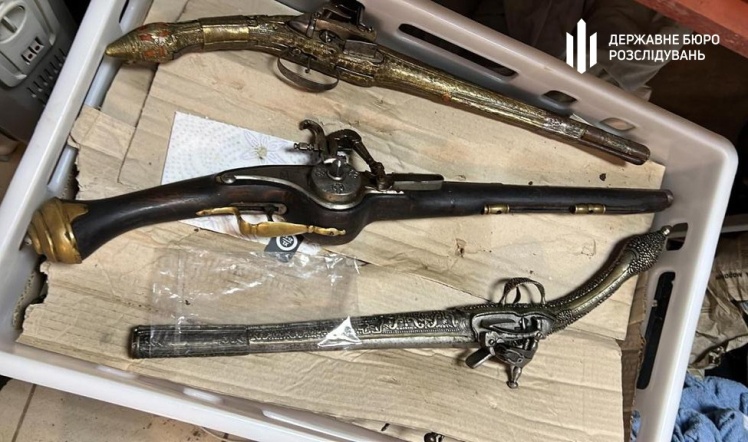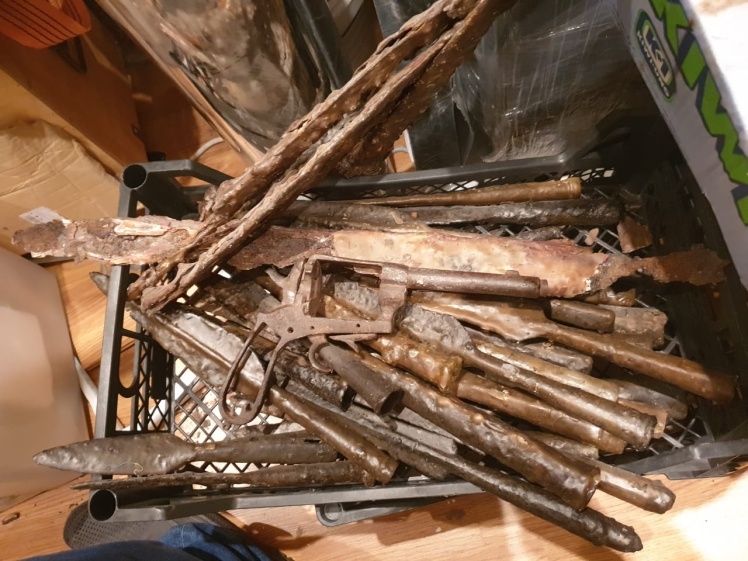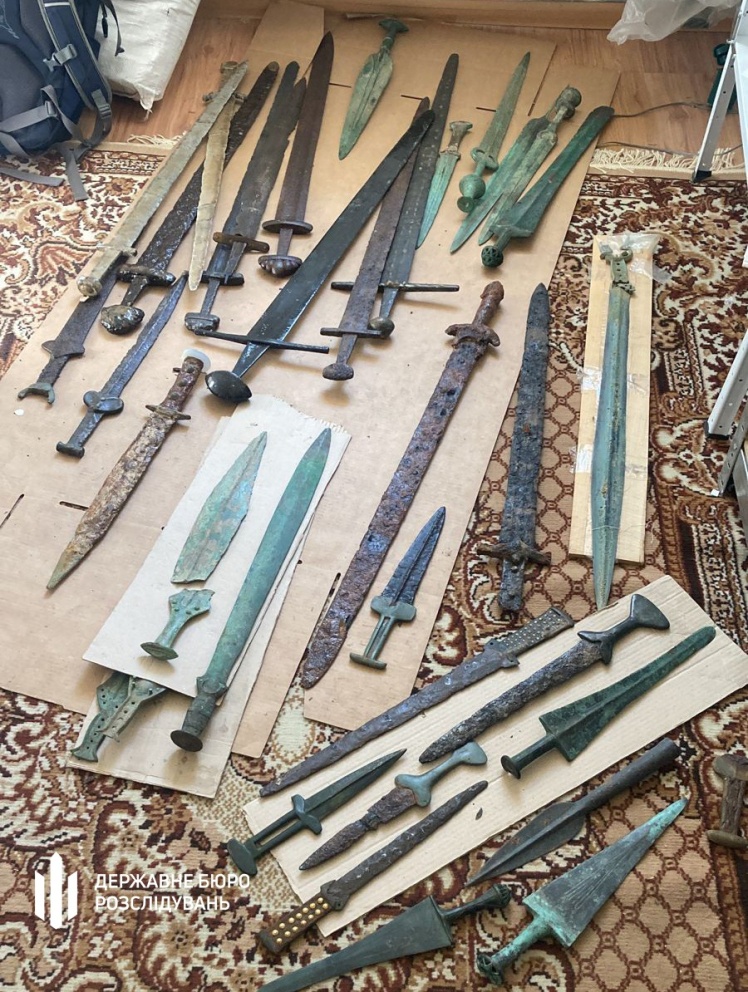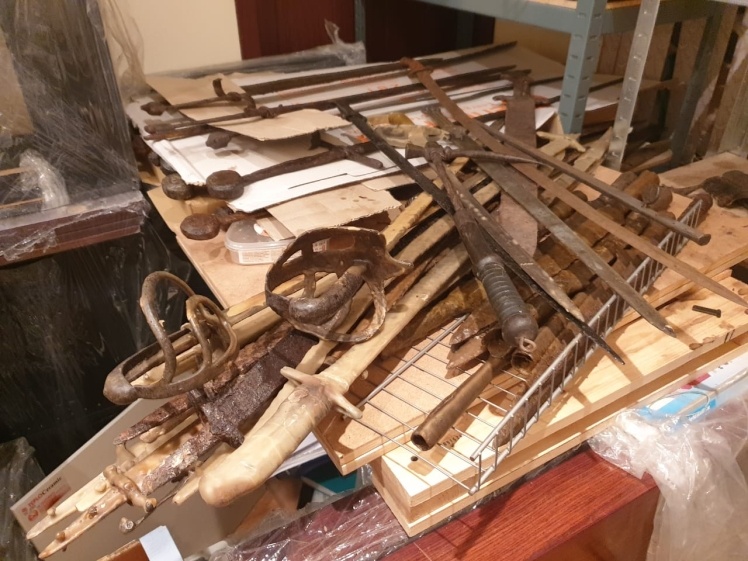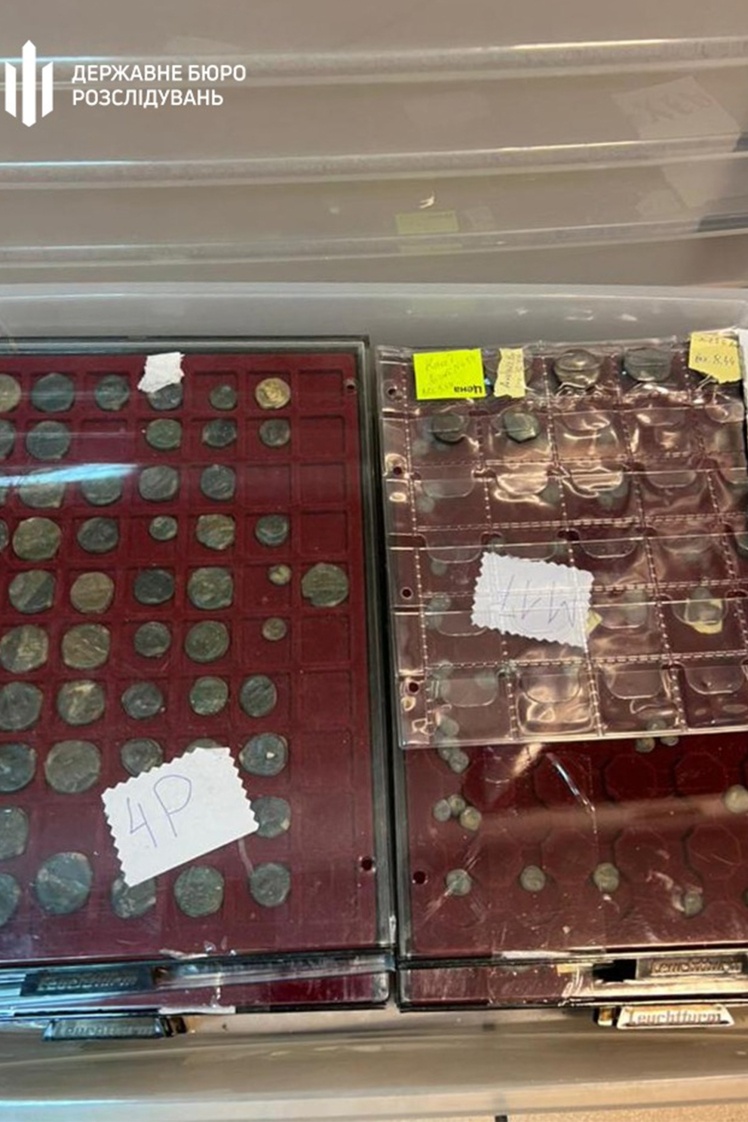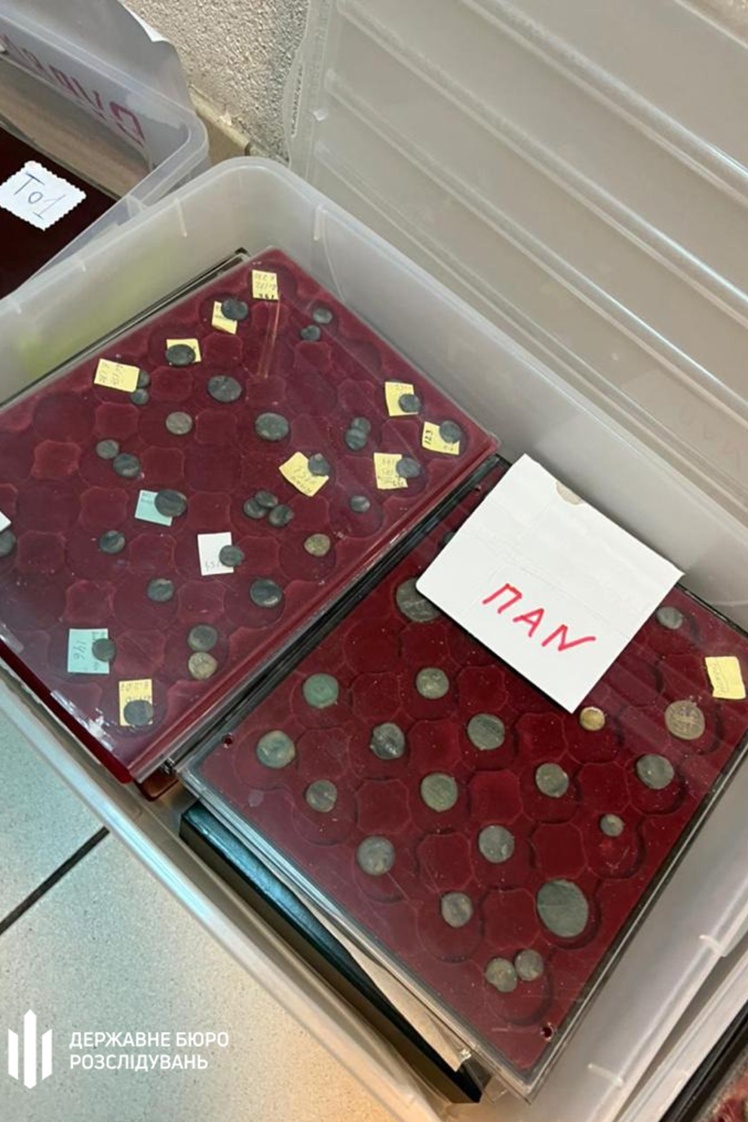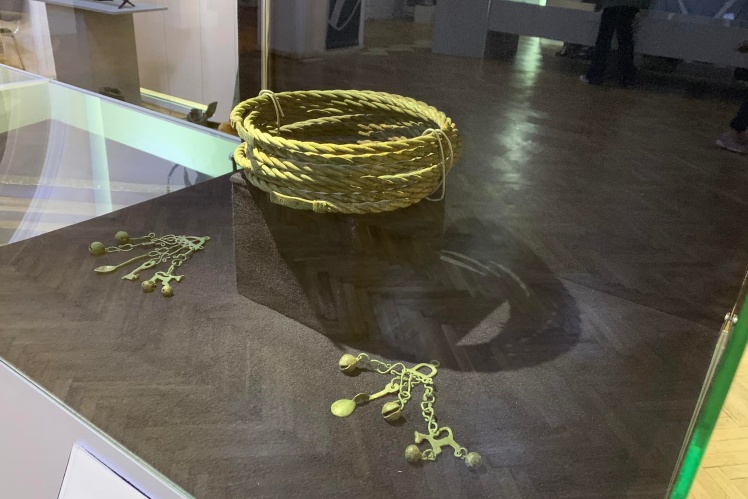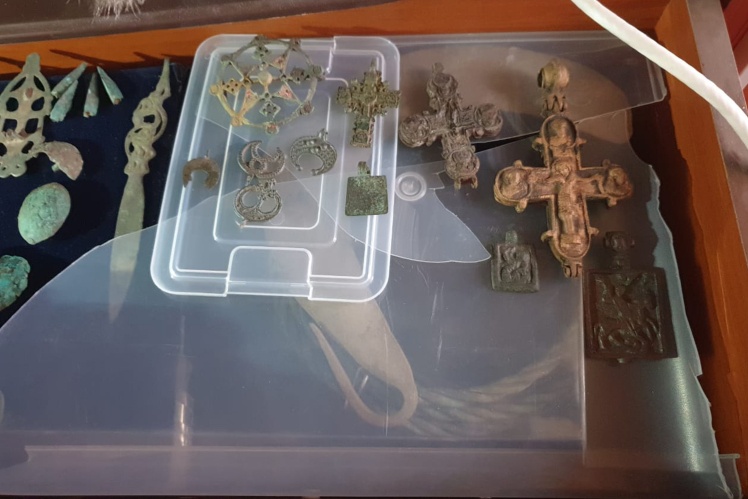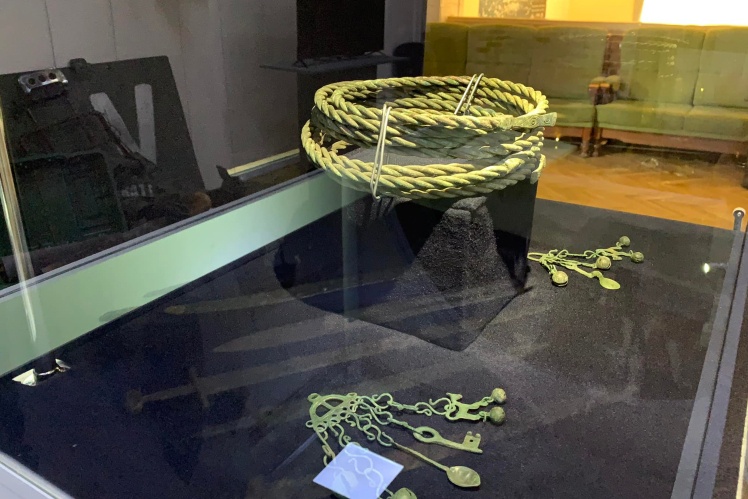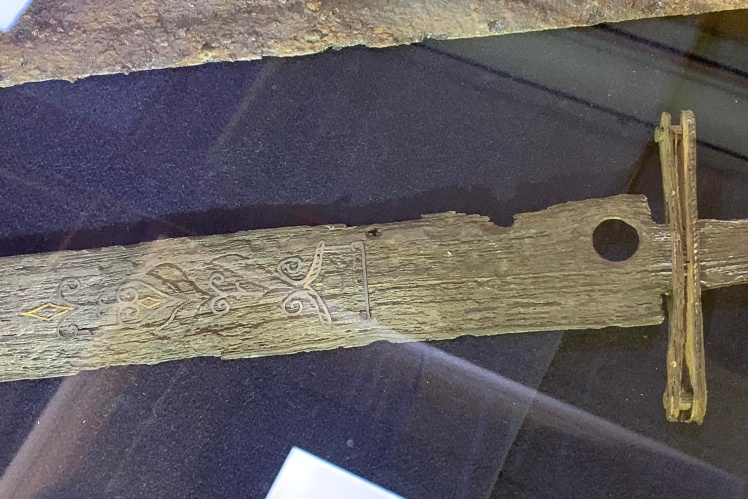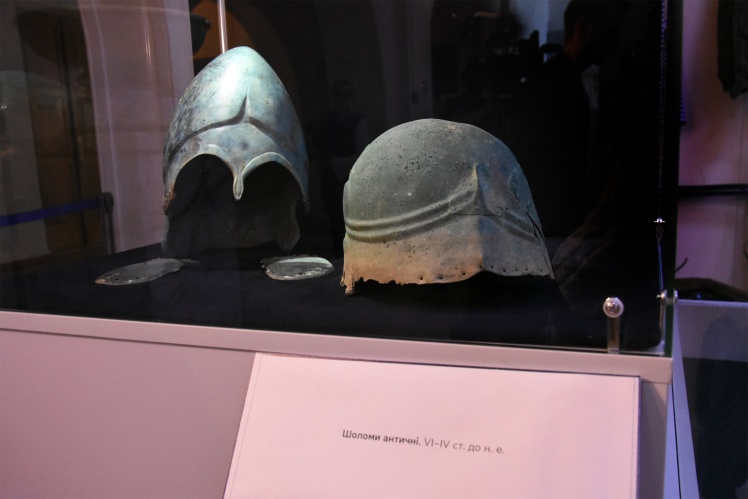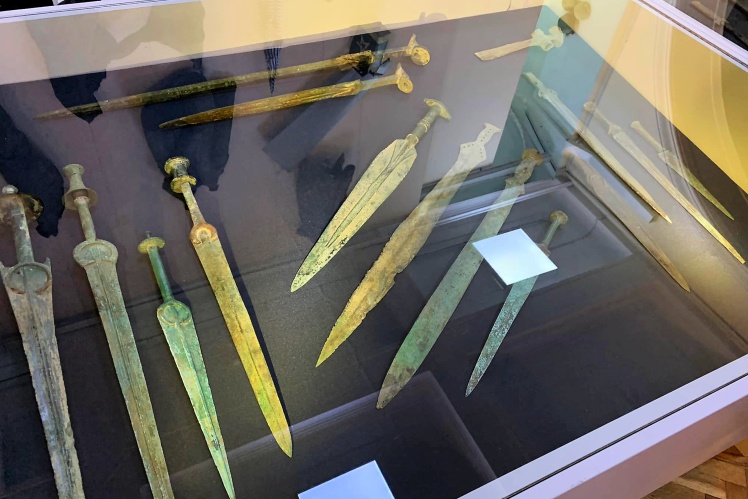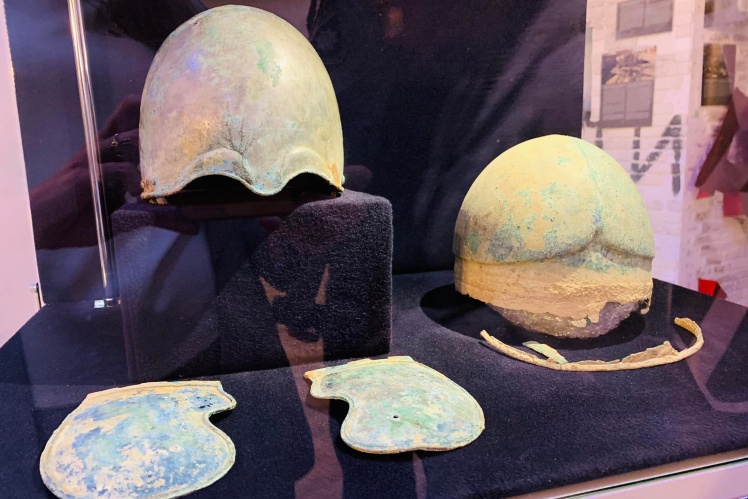1.
On the morning of June 14, investigators entered a room on Yaroslaviv Val Street in central Kyiv. A search of the office of former Crimean Prime Minister Valeriy Gorbatov was carried out as part of an investigation into the financing of the so-called “Donetsk Peopleʼs Republic”, the withdrawal of money from Ukraine to the Russian Federation, and the conduct of business in the occupied Crimea. The penalty under these Criminal Code articles is up to 10 years in prison with confiscation of property.
There are currently no charges of illegal possession of cultural property. The investigation does not comment where Gorbatov is now. According to Babelʼs sources, heʼs not in Ukraine.
During the search, investigators came across numerous artifacts. After consulting with the management, it was decided to invite experts — NMHU employees. Historical treasures were put on the electrical panel and in the attic, stacked in plastic, paper, and wooden boxes, as well as on shelves in a chaotic manner. Due to poor storage conditions, some of them got rusted, some were destroyed.
The searches lasted five days. According to Prosecutor General Iryna Venediktova, 6,066 items worth several million dollars were found. Documents related to Gorbatovʼs business in the occupied Crimea were also found. They are related to the movement of finances in cafes, nightclubs and other establishments. Evidence of Gorbatovʼs business ties with the self-proclaimed Prime Minister of the annexed Crimea, Sergey Aksyonov, was also found. As well as hints that Gorbatov paid "taxes" on the occupied peninsula and in the so-called "DPR".
The found historical artifacts were taken out by two trucks. According to Venediktova, the collection appeared on the electric panel more than eight years ago. Probably, some items were stolen from Crimean museums, and the rest are the work of black archeology. Items came not only from the Crimea, but also from Zaporizhzhia, Mykolayiv, Kherson, Odesa, Kyiv Oblasts, the south of Donetsk Oblast. Investigators say the warehouse did not look abandoned, giving the impression that things were being sorted out from time to time.
— This is the largest illegal collection confiscated in Ukraine. And it is returning to the state, — said the Minister of Culture and Information Policy Oleksandr Tkachenko during a joint press conference with law enforcement officers on June 24 at the National Museum of History of Ukraine.
National Museum of History of Ukraine / «Babel’»
2.
According to Venediktova, among the artifacts found are swords, chain mail, helmets, utensils of the Trypillia culture, sabers, rifles, carabines, amphorae, and womenʼs jewelry. There is a collection of coins — more than 2.5 thousand. Most were found in the Southern Black Sea Coast (temporarily occupied Crimea and southern mainland Ukraine), these items belong to the times of the Scythian and Bosporus kingdoms, the city-state of Olbia.
National Museum of History of Ukraine / «Babel’»
Now the items are material evidence and cannot be seen by regular civilians. As soon as the investigation allows, they will be transferred to the fund of the National Museum of History of Ukraine. However, about three dozen items were shown at the press conference. Among them is neck hryvnia and two pendants for clothes. These artifacts belonged to people of high social status. They are from the cemetery near Bila Tserkva in Kyiv Oblast. This cemetery was looted by black archaeologists after 2010.
— Such jewelry is typical of the Baltic nations who lived in the south-eastern Baltic, — says the director of the NMHU Fedir Androshchuk. — But this is a unique thing. Relatively recently, on the banks of the Ros River in Kyiv Oblast, a burial ground was found. It belonged to Baltic tribes who were relocated here, to Porossia, during the reign of Yaroslav the Wise or Volodymyr the Great.
The cemetery changed the perception of Ukraineʼs ties with Lithuania. It was believed that they were established in the XIV century, but it turned out they already were active in the XI century, adds the head of the Kyiv Archeology Department of Archeology Institute of the National Academy of Sciences of Ukraine Vsevolod Ivakin.
— When criminals snatched our hryvnia from the cemetery, they pulled it along with the backbone, and it left a green mark on the ground, — he says.
Neck hryvnia consists of eight rows of metal plait. The ends are decorated with embossing. The hryvnia was fastened with wire — this is how it was found during a search. Along with other things from the cemetery near Bila Tserkva, it was lying in a plastic box.
National Museum of History of Ukraine / «Babel’»
No Ukrainian museum has a Byzantine sword in its collection. But now one has been found in Gorbatovʼs possession. According to Androshchuk, the weapon originates from the territory of Vinnytsia Oblast and dates back to the IX century.
— The sword was sold at Violity, and I think it was sold, but how it ended up where it was found needs to be researched, — says the NMHU director.
Another sword dates back to the VIII century AD. The blade was encrusted with a plant-like painting. It was a status item. Androschuk says the origin of the sword must be researched. The same applies to the swords of the Vikings of the XI century. Several types were found during the search. One has the inscription Ulfberht — this is the name of the workshop.
The name of the Ulfberht workshop on one of the swords. The blade is inlaid with a painting similar to a plant. Byzantine sword (bottom up), painted sword, three Varangian swords.
National Museum of History of Ukraine / «Babel’»
Among the finds are antique helmets of VI-IV centuries BC. The heroes of Homerʼs Iliad wore similar ones, says Androshchuk. One of the helmets has patches on it.
— The person was hit in the head more than once but continued to repair a helmet, — the director of a museum comments.
Bronze Lurestan swords originate from Iran, but are also found in Ukraine. Scientists do not rule out that they could have got into Gorbatovʼs office from both black archaeologists and students from Syria who smuggled them.
250 Scythian swords — akinaks — were found as well. There are only 100 of them in the NMHU, and itʼs a question if 250 can be found in all Ukrainian museums. Each akinak means one burial place. This illustrates the scale of the robbery.
Lurestan swords made of bronze. Helmets of the Hellenistic era. One of them has patches.
National Museum of History of Ukraine / «Babel’»
Many Gothic womenʼs jewelry was found from the cemeteries of the western Crimea. There are birdʼs heads inlaid with colored stones, made of silver and gilding. They are dated to VI-VII centuries AD.
Among the items is a book Christian sarcophagi of Gaul in French, published in Paris in 1886 and stolen from the library of the National Reserve Tauric Chersonesos. Inside is the seal: "City of Sevastopol, library" is written on it.
Gothic ornament with a birdʼs head. Gothic ornament from the Crimea. Decorations of Gothic culture from the Crimea.
National Museum of History of Ukraine / «Babel’»
3.
Leonid Kuchma first appointed a representative of the President of Ukraine in the Crimea on March 31, 1994. Valeriy Gorbatov was appointed on this post. Vyacheslav Baranov, a researcher at the Archeology Institute of the National Academy of Sciences of Ukraine, says that at the same time people started talking about Gorbatovʼs interest in archeology.
— I myself from the Crimea and knew Gorbatov more as the civil servant who is connected with the power and crime, — Baranov tells. — But I also heard about a person who collects archeology artifacts. It was no secret that many government officials were collecting such items, monitoring and "covering up" black archaeologists who formed criminal groups in Crimea.
Mass looting of burials and crypts on the peninsula began in the 80s of the last century. At first — spontaneously. However, criminal groups quickly entered the "business", as well as law enforcement officers and officials.
At that time Gorbatov was the head of a large collective farm named after Nina Krupskaya in Mykhailivka village in the Nyzhniohirsk district of Crimea. In 1974, the Nogaichyn burial mound was excavated nearby. Artifacts from it are known all over the world: neck hryvnia, dolphin-shaped fibula, round gold brooch. This burial of the Sarmatian queen of the I century BC miraculously survived the robbery.
— I donʼt think Gorbatov was interested in archeology as an art object, — says Baranov. — Rather, [for him] it is a method of enrichment. In the 1990s, such items were virtually worthless on the black market. While in office, Gorbatov could receive them as a gift, in the form of payment or repayment of debt. These were a kind of criminal investment.
For many archaeologists, Gorbatovʼs involvement in collecting was something new. Crimean journalists who worked on the peninsula in the 1990s and later also did not notice him in the context of archeology.
Valeriy Gorbatov
National Museum of History of Ukraine / «Babel’»
— I know Gorbatov as a collector of sanatoriums and land, which he took in his hands while serving on various positions. He also loved horses a lot. And only now I have learned about his passion for archeology. Iʼm surprised — says Valentyna Samar, editor-in-chief of the Center for Journalistic Investigations.
She recalls that Gorbatov was first elected a member of the Ukrainian Parliament when he was head of the collective farm in 1994. At that time, the Presidential Administration was looking for a representative of the President in Crimea — a person who understands Kyiv.
— Gorbatov was elected, although he was not a public person, with a hard temper and an image of "strong manager", — says the journalist. — Most likely, his acquaintance with Anatoly Franchuk, Leonid Kuchmaʼs father of the son-in-law at that time, influenced him.
The institution of the Presidentʼs representative in Crimea was not accepted. In the first and last elections of the president of the peninsula, Yuriy Meshkov won (you can read more about him here), who chanted "Ros-si-ya!". Then his Russia bloc won the elections to the local parliament. It was a time of division of the Black Sea Fleet, separatist movements, and banditry.
— Valeriy Myronovych didnʼt show himself in that situation in any way, — Samar tells. — He sat in a mansion in the yard of the chief of the Navy of Ukraine in the Crimea and practically didnʼt leave it. It was almost impossible to record a comment or an interview with him.
Franchukʼs position strengthened, and at the same time Gorbatovʼs career went up. From 1997 to 1998, he headed the local branch of the State Property Fund in Crimea. And in 2001 he headed the Council of Ministers of Crimea.
At this time, resorts were privatized en masse on the peninsula. The sanatorium were rented out, repaired or reconstructed, which was recorded in the documents as "integral improvements", and because of this it was possible to buy the premises. But with it came all the property: huge plots of land, often with old parks and a coastal area.
Gorbatovʼs capital was registered not on his name, but, for example, on the Crimean Equestrian Association, which he headed, or on his daughter Olga and her husband Andriy Solovyov. The latter was the founder of the Garant SV and Davis companies, which became the owners of the famous Crimean resorts — Mriya in Greater Yalta and Northern Dvina in Alushta.
In 2008, Kommentarii and Poluostrov media outlets reported that Gorbatovʼs fortune was $110 million. He was also credited with owning four smaller health resorts in Evpatoria, Alushta, Feodosia, the local ITV TV company and the Nova Era printing house.
— The jackpot from having this property is the appearance of a big buyer. For example, the sanatorium complex Mriya was purchased in 2010 by the Ukrainian branch of the Russian Sberbank. When Putin first came to the Crimea after the annexation, the party activists gathered in this sanatorium, — says Samar.
In 2010-2012, Gorbatov worked in the Federation of Trade Unions of Ukraine. He was suspected of fraud with the federationsʼ property, Ukrprofozdorovnytsia and the Social Insurance Fundʼs money.
In 2014, Gorbatov reportedly left Ukraine. Cyprus and Russia are named as his possible current location most often. After 2014, it became clear that in 2010ʼs Gorbatov had common business with the self-proclaimed Prime Minister of the annexed Crimea, Sergei Aksyonov. Gorbatovʼs daughter was in a romantic relationship with him. Gorbatov helped Axyonov to become the owner of a business center in Simferopol.
As for antiques, in 2005 the Gorbatov publishing house published a book co-authored with archaeologists Yevhen Turovsky and Mykhailo Stupka: “Ancient weapons and armor. Part I. Copper time”. In 2013, the catalog "Coins of Ancient and Medieval Chersonese" by Turovsky and Gorbatov was published in Simferopol. Both of these authors after 2014 joined the occupation authorities.
National Museum of History of Ukraine / «Babel’»
These books are one of the few public testimonies that connect the Crimean official with artifacts from ancient times. Whether they describe the findings from the switchboard and from the attic in the office on Yaroslaviv Val Street, will be investigated by the officials.
In Crimea, Oleksandr Kozlov was friends with Gorbatov (he joined the occupation authorities in 2014). He owned the Onyx-Tour Speleotourism Center, which operated caves in the Chufut-Kale settlement in the late 1990s and early 2000s. There it was conducting archeological work and selling tickets to tourists. In 2002, Kozlovʼs firm participated in cave research. Then they found the largest treasure of coins since the independence of Ukraine: 4,256 silver ones, 1 copper, 30 gold from XIV-XV centuries, and a silver plate. The treasure weighed more than five kilograms.
4.
Artifacts in Gorbatovʼs office lay and rusted. Archaeologists interviewed by Babel say the site may have been a transshipment point for items to be distributed further. This may explain why no one knew about Gorbatov as a collector, suggests a leading researcher at the Department of Early Iron Age Archeology of the Archeology Institute of the National Academy of Sciences of Ukraine Oleksandr Symonenko.
— It could lie, waiting for the times when the state legalizes such collections. If this happens, the items will become legal goods, will receive documents, and the price will increase many times, especially abroad, — continues Vyacheslav Baranov. — Now everything rests on the fact that legally selling something in the West from Ukraine is problematic. There are cases when they buy our things there and then invent a biography and documents for them.
Due to the availability of metal detectors, the volume of robberies of Ukrainian archeological heritage has no analogs in the world, the archaeologist believes. In the 2000s, the number of robbers was so high that prices for archeological objects fell sharply not only in Ukraine but also in the world. Until then, there were villages in the Crimea, where each family was engaged in black archeology. Adolescents under 12 years of age were most often hired for such work. To plunder a burial ground or a crypt, they dug a narrow pit 1.5 to 2 m deep. Small, light children descended into the gorge. Gradually, they took the ground up and reached the bottom of the burial. Such dugouts often collapsed and covered the children.
Journalist Tetyana Rykhtun investigated black archaeologists in Sevastopol in the mid-2000s. According to her, the robbers were protected by police. On the one hand, law enforcement officers supervised black archaeologists, on the other hand, they took part in these robberies as well. The robbers were conditionally divided into two groups: some were looking for artifacts of the Crimean War and World War II, and others were aimed at objects of antiquity.
— Archaeologists who studied the Second World War or the Crimean War said that it was impossible to approach antiquity. This is a very criminalized business, tied to big money, — the journalist recalls.
5.
According to the Law on the Protection of Archaeological Heritage, the state has the right to everything found during archeological excavations. One canʼt dig illegally. However, owning private collections consisting of Ukrainian artifacts is not prohibited. This is what people take advantage of: even Viktor Yushchenko, who not only demonstrated the collection, but also as president, recalls Tatiana Rykhtun, took care of many archeological expeditions in the Crimea.
Among the famous collectors are businessmen Serhiy Taruta and Serhiy Platonov, owners of the private Platar collection. It consists of Scythian gold, Trypillia ceramics, antique ornaments, bowls, amphorae, fragments of sculptures, objects from the times of Kyivan Rus. Businessman Oleksiy Sheremetyev opened a museum of the same name with artifacts of Kyivan Rus, the Grand Duchy of Lithuania, the Cossack era, and more.
In the middle of the 2000s it was said that there are more than five thousand private collectors in Ukraine. Some of them did not hesitate to illegally bring antique mosaics from Syria and Lebanon and restore them here. But after 2014, the antiques market changed, archaeologists say to Babel. Earlier, gifts to high-ranking officials were sought from antiquarians. When Viktor Yanukovych and other figures fled Ukraine, the market shrank: there were no more people with crazy money and requests for archeology.
Yakiv Hershkovych, the head of the Union of Archaeologists of Ukraine, tells Babel about the private collection of the artifacts of cultural value.
From left to right: Prosecutor General Iryna Venediktova, Interior Minister Denys Monastyrskyi, NMHU Director General Fedir Androschuk (at the microphone), Minister of Culture and Information Policy Oleksandr Tkachenko during a joint press conference.
National Museum of History of Ukraine / «Babel’»
— There is no direct ban on this not only in Ukraine, but everywhere in the world. States intervene in the circulation of cultural values only in extreme cases, — says Gershkovych. — In Ukraine for many years there is a mechanism of robbery of archeological sites. Demand for such items is created by private collectors. It is very difficult to prove the criminal origin of archeological artifacts in modern collections. The only consolation is that the problem has not been solved anywhere in the world.
In many countries, the collection of archeology items is limited, says archaeologist Baranov, so as not to encourage robbers. In Ukraine, in contrast, one can join groups on Facebook where people openly flaunt archeological robberies.
— I insist that any archeological thing found privately in Ukraine cannot be legal. According to the law, archeology artifacts are owned by the people of Ukraine, these objects cannot be in free circulation, — he says. — There were no private collections that would be formed before Ukraineʼs independence, respectively, the artifacts canʼt be inherited. Because even in Soviet times it was illegal.
In December 2021, at a hearing in the parliamentary Committee on Humanitarian and Information Policy, archaeologists proposed to change the legislation. In particular, limit the private collection of archeological objects, indicating what can and cannot be collected. It was proposed to regulate the circulation of metal detectors (discussed in the parliament since 2013) and to prescribe the rules of Ukrainian online auctions, through which every year passes a number of archeological objects which exceeds the archeological funds of the National Museum of History of Ukraine.
— There are many such "gorbatovs" in Ukraine, and the example of the seized artifacts shows how massively the archaeological heritage is being stolen, — says Vyacheslav Baranov. — Therefore it is first of all a question of education. No law will work if people donʼt understand that our history is being destroyed. There is an opinion, they say, whatʼs wrong with this? “I just found it on the field.” But archeology studies the context. When a thing is taken out of the place where it was found, it loses its value. Because we cannot investigate why people came to these lands, what this space was for them. It is a question of whether a person understands his place in history.
Translated from Ukrainian by Anton Semyzhenko.
We are against any "black" schemes, so please help us honestly: donate in hryvnia 🔸 in cryptocurrency 🔸 Patreon 🔸 PayPal: [email protected]


